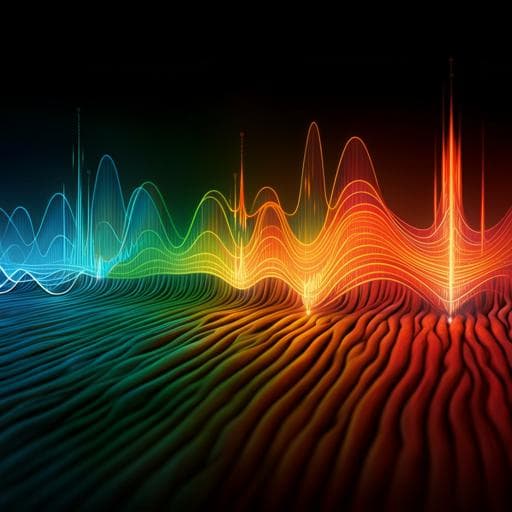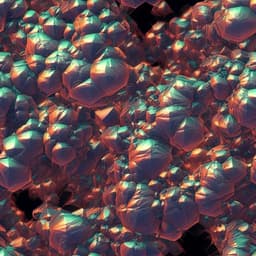
Health and Fitness
In vivo oscillations of the soleus muscle can be quantified using b-mode ultrasound imaging during walking and running in humans
A. K. M. Lai and E. F. Hodson-tole
This groundbreaking study by A. K. M. Lai and E. F. Hodson-Tole explores the fascinating dynamics of soleus muscle oscillations during walking and running. It reveals how increased vertical impact forces at faster speeds influence muscle behavior, showcasing ultrasound imaging as a powerful tool in understanding these responses. A must-listen for those intrigued by biomechanics!
~3 min • Beginner • English
Introduction
Impact forces during locomotion act as input signals that must be dissipated to reduce injury and fatigue risk. While joint stiffness adjustments are often implicated, soft-tissue vibrations, including those of skeletal muscle, likely contribute substantially to damping. Existing in vivo observations largely rely on skin-mounted devices, which are susceptible to motion artifacts and may not reflect deeper muscle behavior. Ultrasound imaging provides a means to directly observe muscle and aponeurosis motion. This study aimed to test whether dynamic 2D B-mode ultrasound can quantify transverse oscillations within the soleus (SO) during locomotion and how these oscillations change with impact input frequency as walking and running speeds increase. The hypotheses were: (1) faster steady-state walking and running increase ground impact input frequency; and (2) increasing speed increases the power and frequency content of in vivo transverse oscillations measured at the superficial and deep SO aponeuroses during stance.
Literature Review
Prior work has modeled soft-tissue wobbling masses and used skin-mounted accelerometers or surface markers/painted grids to infer soft-tissue vibrations during locomotion, showing contributions to impact signal dissipation and muscle tuning with activation. However, skin measurements can be decoupled from deeper soft tissues and mix translational, rotational, and gravitational components, complicating interpretation. Ultrasound has been extensively used to quantify muscle fascicle architecture (length, pennation), thickness, and aponeurosis behavior during dynamic tasks, particularly in the ankle plantar flexors (SO, MG, LG). Reported input frequencies during running are typically 10–30 Hz, and soft-tissue vibration frequencies during impacts can span roughly 14–40 Hz, but these largely derive from skin-mounted measures amalgamating multiple tissues. A direct, muscle-specific in vivo measure during locomotion has been lacking, motivating the present ultrasound-based approach.
Methodology
Participants: Ten healthy adults (9M/1F; age 27±6 years; height 1.81±0.08 m; mass 80.2±11.7 kg) walked and ran on a treadmill at steady-state speeds: walking 0.7, 1.4, 2.0 m/s; running 2.0, 3.0, 4.0, 5.0 m/s. Foot strike pattern was self-selected; three rear-foot strikers across all running conditions, three mid-foot strikers across all running conditions, and four switched to mid-foot at 5 m/s. Minimalist footwear was used. Ethics approval (Univ. of Queensland, Ref. 2012001215) and informed consent were obtained.
Data acquisition: All systems synchronized via ultrasound trigger. Motion capture (Qualisys) at 250 Hz; ground reaction forces (instrumented treadmill) at 2000 Hz; SO EMG (Noraxon) at 2000 Hz using surface electrodes per SENIAM. Ultrasound: PC-based B-mode (Telemed Echo Blaster 128), 7 MHz flat transducer, 60 mm width × 50 mm depth, sampling at 80 Hz. Probe placed at LG mid-belly aligned to image SO superficial and deep aponeuroses; secured with bandage to minimize probe motion. Right leg imaged.
Preprocessing: Marker trajectories low-pass filtered (4th-order Butterworth) at 20 Hz; GRF at 60 Hz. EMG processed by wavelet intensity analysis (von Tscharner) using 11 nonlinearly scaled wavelets covering 6.90–395.44 Hz; first wavelet excluded from total intensity to mitigate motion artifacts. EMG intensity normalized to participant peak across conditions.
Ultrasound segmentation: Active shape model (ASM) with participant-specific training on frames from running at 3 and 4 m/s. Landmark model: 19 evenly spaced points (x,y), 32 pixels apart, spanning image width for both superficial and deep SO aponeuroses. Multi-resolution ASM using intensity gradients, minimizing Mahalanobis distance relative to trained intensity models; new shapes constrained within 3 SD of shape distribution. Visual inspection performed; one participant excluded due to indistinct deep aponeurosis, yielding N=9. Approximately 37,000 images processed.
Analysis windows: Four stance phases analyzed per condition per participant. Transverse displacement of each landmark (deep-superficial relative to probe) computed across stance, resampled to 100 points, normalized to static standing landmarks, and averaged (mean±SEM). Regions defined: distal (landmarks 2–6), mid (8–12), proximal (14–18).
Input signal frequency: From vertical GRF, compute rate of force development (time derivative). Input frequency estimated as inverse of time between maximal rate of force development and maximal impact force (representing a quarter cycle of the impact oscillation).
Power-frequency analysis: Landmark transverse displacements high-pass filtered (4th-order Butterworth) with cutoff equal to stride frequency per condition (1.3, 1.8, 2.4, 2.6, 2.7, 2.9, 3.1 Hz for walk 0.7, 1.4, 2.0 m/s; run 2, 3, 4, 5 m/s). FFT-based power spectra computed 0–40 Hz (limited by 80 Hz sampling). Metrics extracted per landmark and region: peak power (mm²) and cumulative frequency at which 50% of total spectral power is reached.
Statistics: One-way repeated measures ANOVA tested input frequency differences across conditions. Two-way repeated measures ANOVAs (factors: locomotion condition, image region) assessed effects on peak power and cumulative frequency for superficial and deep aponeuroses separately. Bonferroni post hoc tests applied when appropriate; alpha=0.05.
Key Findings
- Input signal frequency increased significantly with walking and running speed (p<0.001). At 2.0 m/s, walking vs running showed slightly higher input frequency in walking (13.6±1.6 Hz vs 10.6±0.5 Hz), but not statistically significant (p=0.8).
- SO EMG showed stance-phase activity across all conditions, with peak intensity increasing with faster walking (late stance) and faster running (early–mid stance).
- Transverse displacement patterns of superficial and deep aponeuroses were similar across conditions: initial deep displacement early in stance, return toward baseline mid-stance, and deep shift again near push-off. With increased walking speed, initial transverse displacement magnitude increased; with increased running speed, peak-to-peak displacement decreased. Distal region landmarks displaced more than proximal across both aponeuroses.
- Power-frequency analysis: Significant main effects of locomotion condition on peak power for superficial (p<0.001) and deep (p=0.002) aponeuroses. Average peak power increases: +2.8 mm² with increased walking speed; +9.2 mm² with increased running speed.
- Relationship with input frequency: Deep aponeurosis peak power vs input frequency fit linearly (r²=0.85; y=0.05+0.84x). Superficial aponeurosis showed a reasonable linear relation (r=0.65) but better quadratic fit (r²=0.93; y=2.86–0.18x+0.04x²).
- Cumulative frequency (50% power) showed significant main effects of locomotion condition and image region for both aponeuroses (locomotion both p<0.001; region superficial p=0.016, deep p=0.043). Cumulative frequency approximately doubled from walk 0.7 to 2.0 m/s and from run 2.0 to 5.0 m/s. Distal vs proximal regions differed by ~1.6 Hz on average across conditions.
- Frequency content: At fast running, 50% of signal power was below ~14 Hz, versus below ~5 Hz at slow walking, indicating a shift toward higher frequency components with speed.
- Superficial LG aponeurosis (examined secondarily) showed very low peak power (≤1.24 mm²) and cumulative frequency ≤13 Hz across conditions, likely due to probe strapping/compression, contrasting with soleus results.
Discussion
The study demonstrates that dynamic B-mode ultrasound with computational segmentation can capture in vivo muscle-specific oscillations induced by locomotor impact, addressing limitations of skin-mounted measurements that amalgamate multiple tissue motions and suffer from motion artifacts. Consistent with prior literature, input frequencies increased with speed (approximately 10–20 Hz), and the ultrasound-derived oscillations exhibited greater power and higher frequency content with increased input frequency. Regional differences (distal > proximal) and distinct superficial vs deep aponeurosis behaviors argue against probe motion artifacts as the dominant signal source. While input frequency at 2.0 m/s was slightly higher during walking than running, superficial peak power was lower (and deep similar) during walking, potentially reflecting differences in activation timing/magnitude (EMG) and foot-strike patterns that modulate muscle tuning. Observed cumulative frequencies (~5–15 Hz) are lower than some accelerometer-based reports, likely because ultrasound isolates muscle-specific behavior and is limited by sampling and analysis bandwidth. Methodological constraints (e.g., probe compression, sampling rate, field of view, fixed image reference) shape the measurable oscillation content, yet the spectra and multi-peak structures align with known soft-tissue vibration complexities. These findings support the hypothesis that faster locomotion increases input frequency and that muscle oscillations in the soleus scale in power and frequency with this input, providing a framework for studying how muscles dissipate impact under different external conditions.
Conclusion
2D ultrasound imaging combined with image-based segmentation can quantify transverse oscillations of the soleus aponeuroses during walking and running. Muscle oscillation power and frequency content increase with higher input signal frequency as locomotion speed rises. This validates ultrasound as a tool to assess muscle-specific oscillatory responses to impact, especially in deeper muscles, and to evaluate the influence of external factors such as footwear and surface properties on impact dissipation to potentially reduce fatigue and injury risk. Future work should incorporate higher sampling rates and wider fields of view to capture longitudinal traveling waves and higher-frequency content, analyze time-domain displacement/velocity/acceleration, minimize probe compression, and systematically examine the roles of activation patterns and foot-strike strategies.
Limitations
- Ultrasound sampling rate (~80 Hz) constrained frequency analysis to ~0–40 Hz and limited resolution of fast transient events; impact-related oscillations during fast running may be represented by few frames.
- Probe strapping/compression likely damped oscillations in superficial tissues (e.g., LG superficial aponeurosis), suggesting current methods are better suited to deeper muscles.
- Analysis tracked displacements at fixed image locations while the muscle translates through the field of view, so point locations do not correspond to fixed anatomical regions across stance.
- Longitudinal (proximal–distal) traveling wave oscillations were not directly quantified; only transverse motion analyzed.
- Foot-strike patterns were not controlled; preliminary comparison suggested potential influences (~5 Hz difference in cumulative frequency between individuals with different strike patterns).
- One participant excluded due to poor visibility/segmentation of the deep aponeurosis; small final sample (N=9).
- Limited generalizability to overground locomotion and different footwear/surface conditions beyond the minimalist shoes and treadmill used.
Related Publications
Explore these studies to deepen your understanding of the subject.







